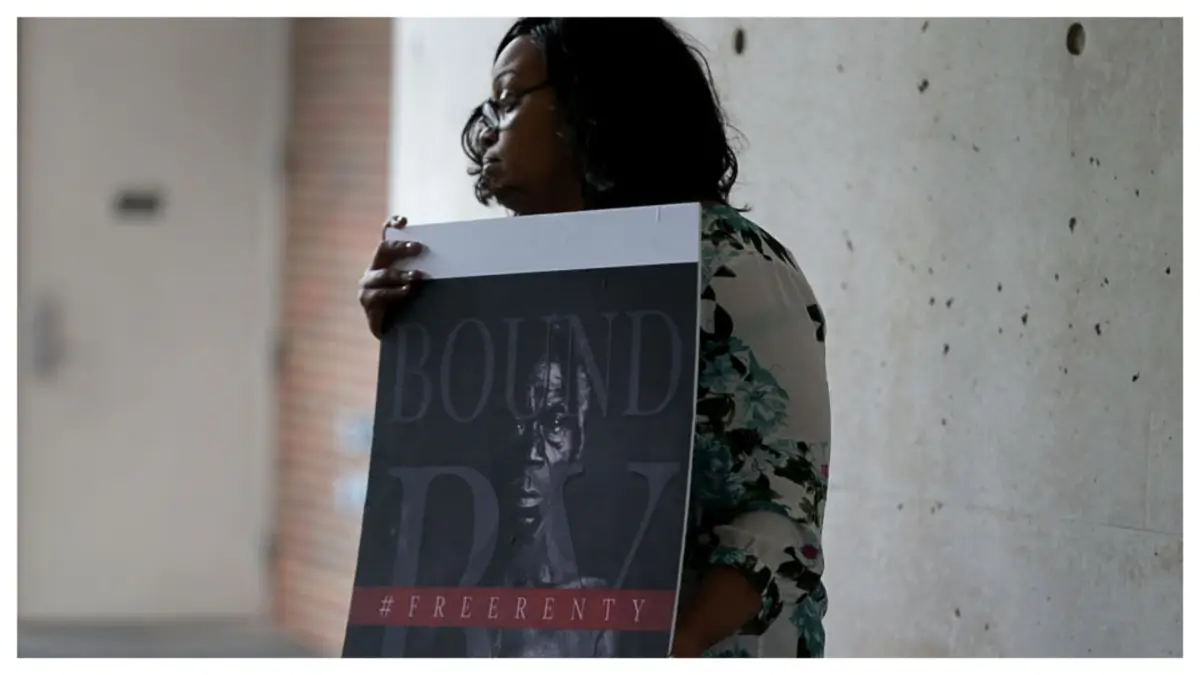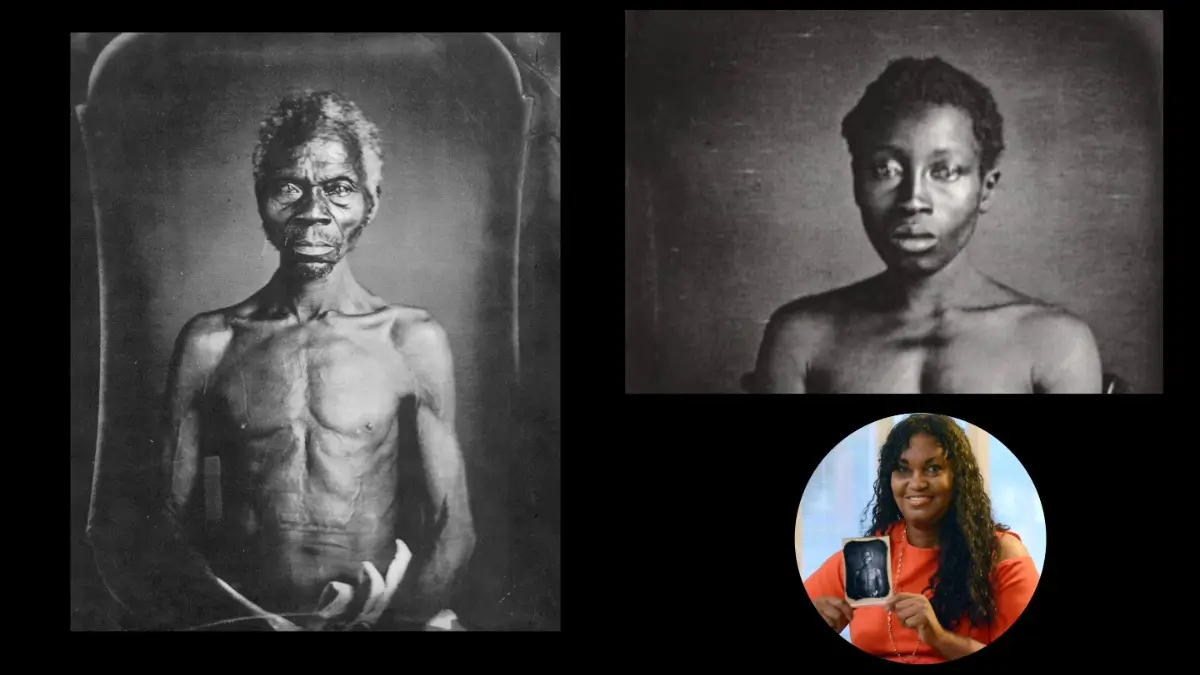After a long legal battle, Harvard University agreed to relinquish ownership of disturbing 175-year-old photographs of an enslaved father and daughter as part of a settlement with a Black woman who made a compelling case for being their descendant.
The photographs will go to an African American history museum in South Carolina, the state where the subjects of the photos were enslaved and, in 1850, captured on silver-coated copper daguerreotype plates for a project commissioned by Louis Agassiz, a Harvard professor who visited plantations seeking “specimens” from Africa to shore up his discredited pseudoscientific theory of Black racial inferiority.
Plaintiff Tamara Lanier first contacted Harvard in 2011 about the photos, which she says depict her great-great-great-grandfather Renty Taylor and his daughter Delia, after learning of their existence while doing genealogical research on her family.


According to her lawsuit, her mother Mattye Thompson often told the story of their family which began with a man known as “Papa Renty” or “the Black African,” who was a courageous man who defied slavery’s tyranny by teaching himself and others to read and by conducting secret Bible readings on the plantation in South Carolina where he was enslaved.
After her mother died in 2010, Lanier, who lives in Norwich, Connecticut, set out to document the family history, searching online resources, libraries and archives in South Carolina. That included census records and a handwritten inventory from 1834 of the slaves on the plantation of Col. Thomas Taylor of Columbia, South Carolina, and their values, noted The New York Times. Based on this research, she concluded that she is the direct lineal descendant of Renty Taylor.


In March 2011, she wrote to the then-president of Harvard, Gilpin Faust, seeking to confirm that two individuals among a set of rare daguerreotypes of formerly enslaved persons that had been discovered in the attic of the university’s Peabody Museum of Archaeology and Ethnology archives in 1976 were indeed her ancestors. She also asked Harvard to let her know how the images “have [been] or will be used.”
Faust thanked Lanier for sharing her story and said the museum was involved in “an ongoing project involving those daguerreotypes,” according to the complaint. She said her staff would be in contact if they “discovered any new relevant information.” But Harvard never contacted Lanier about verifying her lineage or updated her on any of its projects related to the daguerreotypes, which included haunting images of Renty and Delia stripped naked to the waist and staring solemnly into the camera.
In 2017, one such image of Renty Taylor was used on the cover of an anthropology textbook published by Harvard University Press, as well as on the front cover of a program for a conference on universities’ historical connections with slavery.
Lanier and her daughters attended that conference, and were aghast to see Renty’s image projected on a large stage, as well as to read the caption for the program, which said Renty “lived and worked as a slave in South Carolina in 1850, when his photo was taken for the Harvard professor Louis Agassiz as part of his scientific research. While Agassiz earned acclaim, Renty returned to invisibility.”
This description “took [her] breath away,” the complaint says, not only because it omitted “the racist and dehumanizing” nature of Agassiz’s work, but also because it “relegate[d] Renty to ‘invisibility’ in “flagrant disregard for [her] repeated attempts to share his story and restore a measure of humanity that Agassiz [had] stripped from him.”
Lanier fired off another letter to Faust, demanding that the daguerreotypes of Renty and Delia be “immediately relinquished” to her in October 2017.
When Harvard didn’t acknowledge her demand, she sued the Ivy League university in Middlesex Superior Court in March 2019, alleging unauthorized use of a portrait or picture, violation of state civil rights law, intentional harm to a property interest, negligent infliction of emotional distress, and sought equitable restitution to include monetary relief and the transfer of the daguerreotypes to her. She also asked for Harvard to acknowledge its complicity in slavery.
Lanier claimed that the photos were taken against the will of her ancestors, and that the university had exploited the portraits for profit.
In 2021, a state judge dismissed the case, siding with Harvard, which argued that Lanier had no legal claim to the photos, reported AP News. In her decision, Middlesex Superior Court Judge Camille Sarrouf said that law dictates the photos are the property of the photographer, not the subject, “regardless of how objectionable the photograph’s origins may be.”
Civil rights attorney Ben Crump appealed the case to the Massachusetts Supreme Judicial Court, which in June 2022 agreed that Lanier had no ownership interest in the daguerreotypes, which (unlike photo negatives, which are often owned by a photographer) were original creations rightly delivered in 1850 by photographer Joseph T. Zealy to Agassiz and Harvard, who had paid for them.
But the court found merit in Lanier’s claims that Harvard had intentionally inflicted emotional distress on her in its “cavalier” and dismissive treatment of her and allowed that part of her lawsuit to proceed, remanding the case back to the superior court.
“We conclude that Harvard’s present obligations cannot be divorced from its past abuses,” the court ruled. “In light of Harvard’s complicity in the horrific actions surrounding the creation of the daguerreotypes … once Lanier communicated her understanding that the daguerreotypes depicted her ancestors and provided supporting documentation … a duty to respond to her requests with due care was triggered.”
Chief Judge Scott L. Kafker, who wrote the opinion, expressed some regret that “the plaintiff now faces a legal system several generations later devoid of a sufficient remedy for the injuries and injustices she has faced as a descendant of enslaved Africans and African-Americans. … Thus … current law impermissibly ‘rewards wrongdoers — even criminals — and their sponsors with the spoils of their wrongdoing.’”
“The wrong the plaintiff alleges, and that I would address, is Harvard’s continued wrongful retention of the daguerreotypes, which were created specifically as a consequence of the enslavement of the plaintiff’s ancestors and concomitant wrongdoing by Agassiz and Harvard, are a vital component of the plaintiff’s family lineage, and are a source of a meaningful familial connection, physically and emotionally, between the plaintiff and her ancestors,” he wrote.
Kafker also quoted in his opinion Henry Louis Gates, Jr., the historian and host of the PBS Series “African-American Lives” (whose genealogists found Lanier’s claimed lineage convincing and who wrote the forward to a comprehensive book on the Zealy Daguerreotypes published in 2020 by Harvard’s Peabody Museum) as follows:
“So long as the daguerreotypes remain under the defendants’ control, Renty and Delia remain cherished members of the plaintiff’s family who are relegated to an existence as ‘enslaved subjects trapped inside the frame — subjects who, from the very first exposure, were intended to exist more as objects and symbols of American slavery than as fully realized human beings with the ability either to represent themselves through — or withhold themselves from — the camera.’”
According to the settlement announced this week, the images of Renty, Delia and five other enslaved people will be transferred to the International African American Museum in Charleston, South Carlina, which has committed to working with Lanier and including her in decisions about how the story of the images will be told.
“I have been at odds with Harvard over the custody and care of my enslaved ancestors, and now I can rest assured that my enslaved ancestors will be traveling to a new home,” Lanier told the New York Times. “They will be returning to their home state where this all began, and they will be placed in an institution that can celebrate their humanity.”
A Harvard spokesman told the Times that the university was always eager to place the images in an appropriate public location.
“While we are grateful to Ms. Lanier for sparking important conversations about these images, it is inaccurate to say that Harvard resisted her ‘requests,’” James Chisolm, the spokesman, said in a statement on Wednesday. “This was a complex situation, particularly since Harvard has not confirmed that Ms. Lanier was related to the individuals in the daguerreotypes.”
Lanier’s attorney Joshua Koskoff told The Associated Press that despite Harvard’s reticence to acknowledge Lanier’s connection to Renty and Delia, the settlement, which includes undisclosed financial damages, speaks for itself.
“In the end, the truth will find you — you can only hide from it for so long,” he said. “Yes, history is written by the winners. But over time, you know, those winners look like losers sometimes.”
Crump called the case “precedent-setting in so many ways,” telling The Times, “It does leave a bright trail for not just us but the next generation of civil rights lawyers to take up the cross and to continue to defend Black humanity on every level.”








